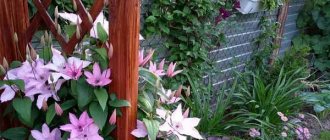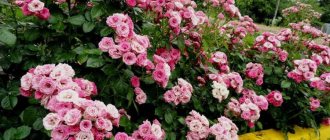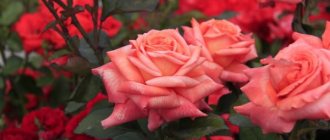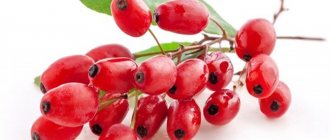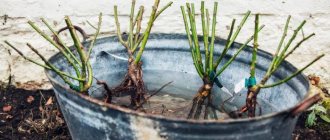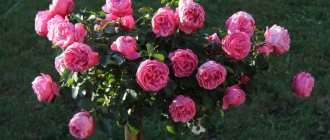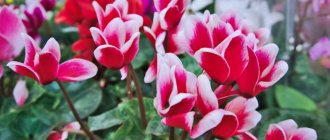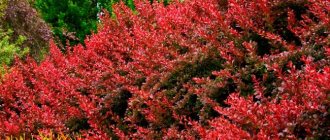Features of barberry and rules for planting it
Barberry is an ornamental plant from the genus of shrubs of the Barberry family. In the wild, the culture is widespread in mountainous areas. There are 170 plant species, some of them are grown in garden plots and are also used in landscape design.
For gardeners, barberry is of interest primarily as a raw material base for the production of juices, jams, sauces, and medicinal tinctures. The decorative qualities of the crop are expressed in the variety of leaf colors: yellow, green, purple, carmine red, variegated, spotted.
The table shows suitable and unsuitable conditions for growing shrubs. The information will be useful for novice gardeners.
| Conditions | Fits | Doesn't fit |
| Soil moisture | Deep groundwater. | Swampy, too wet areas. |
| Illumination | The more sun, the brighter the leaves, the better the bushes grow, the sweeter the fruits. | In dark places, the plant loses its decorative effect, the leaves acquire a faded green color, the fruits grow worse, and the plant develops more slowly. However, in the shade the root system develops more actively, which allows the bush to be propagated by division. Gardeners often practice temporary planting in the shade for this very purpose. |
| Winds | Quiet area protected by a fence, outbuildings and other plants. | Open area with drafts. |
| Rockiness | Rocks with a small turf layer, pebble river areas, fertile breathable soil, loam. | Clogged clay soil. The problem can be easily solved with the help of river sand and careful loosening. |
| Soil acidity | Normal (pH = 7), slightly acidic (pH = 6-4), slightly alkaline (pH = 7-8) | Alkaline (pH ≤  |
Description of the plant
Barberry is one of the oldest plant families. The main species is the common barberry (Berberis vulgaris) which is very variable. More than 400 species grow naturally in Asia, North and South America, Africa, and Europe.
In our country, the plant is found naturally on slopes, plains, and forest edges, where it creates characteristic dense thickets. Barberries of different types are evergreen and deciduous. The bush is characterized by triple-thorned stipules that actually turn into leaves. Many varieties change the color of their leaves from green to red, purple, and yellow in the fall, decorating the landscape outside the window on cold autumn days.
Barberry can be divided into 2 categories:
- deciduous varieties;
- evergreen varieties.
Typically, gardeners choose deciduous varieties; they are the most common. As a result of interspecific crossings and appropriate selection, the choice of plants is huge:
- varieties with proudly raised branches;
- with lazily hanging shoots;
- low varieties.
You can read more about barberry varieties here -
The small leaves of barberry, like the flowers, are collected in bunches and grow densely on the long shoots of the plant. In May and June, fragrant small yellow or orange flowers appear on the shrubs. All species and varieties have bisexual flowers, 0.5-2 cm in diameter, solitary or collected in clusters. Flowers are self-pollinating, but can also be pollinated by pollen from other species. Pollen is carried by insects, such as bees and bumblebees.
At the end of summer, oblong fruits several millimeters long appear, reaching maturity in the fall. The fruit is spherical or slightly elongated, not very large, red, or black in evergreen species.
Barberry berries are usually red or dark blue in color and have a sour taste.
The berries can hang on the bush until spring, which, unfortunately, is rarely possible - birds adore them.
Deciduous species are quite frost-resistant and suitable for growing in central Russia, these are:
- B. Thunberg (Berberis thunbergii);
- B. common (B. vulgaris);
- B. Korean (B. koreana).
There are many varieties of the plant, differing in leaf color, shape, and growth. Therefore, barberry is readily grown in green areas, parks, and garden plots. The shrub is used to create unformed lines, form hedges (especially in columnar varieties), as a ground cover plant, and, thanks to the varied color of the leaves, as a typically ornamental plant.
Barberry Thunberg is one of the most popular species. Grows well in any garden - undemanding, very decorative. The varieties vary in height; you can find a suitable variety for a small or large garden.
When is the best time to plant
Barberries are traditionally planted in spring or autumn. Experienced gardeners practice autumn planting so that the bushes have time to take root in a new place. A plant planted in spring spends a lot of energy growing roots and flowering at the same time. A decrease in growth rate is often observed. However, if you did not find suitable planting material in the fall or did not have time to prepare it, do not worry, carry out planting work in the spring.
If possible, select seedlings with a clod of earth. Its young roots are protected by the soil, so it will take root on the site without problems.
Reference. Seedlings with a closed root system are planted in spring, summer and autumn.
Nuances for different regions
We have already figured out where to plant barberry. Now let's move on to the issue of planting crops in different regions.
Spring planting of barberry is carried out as soon as above-zero temperatures are established, regardless of the region. This is the same rule for all areas.
In the Moscow region, Leningrad region, the Urals and Siberia, barberry is planted in the second ten days of April or in late September - early October, before the first frost. The plant will have time to take root in a new place and survive the winter without loss.
In the south of Russia, spring planting is carried out in March, and autumn planting is carried out in late October - early November.
Growing and care
Barberry is easy to grow and requires virtually no care.
Watering
Barberry tolerates the vagaries of the weather well; it should be watered only during prolonged drought; the shrub does not like excessive amounts of water. Plants tolerate drought better than waterlogging.
Careful care of barberry thunberg (red) is required. It should be watered carefully, at the root, without wetting the leaves due to the increased risk of fungal diseases.
Feeding
Barberry does not need fertilizer. On very poor soils, if you want the bush to be beautiful and lush, you can sprinkle the soil around with granular multicomponent mineral fertilizer. Apply 2 doses of fertilizer per year, with an interval of 3 weeks.
Natural fertilizers are also suitable - chicken droppings, cow manure, nettle infusions. 2-3 doses of fertilizer with an interval of 2-3 weeks are enough.
Wintering
Barberry is a frost-resistant plant; in our climate it does not need to be covered. Even if some shoots freeze, they should be pruned, the plant will quickly recover.
Therefore, you can grow barberry in the Moscow region and in Siberia, the Urals, and the Far East. Amur barberry, for example, grows well in Transbaikalia and the Amur region and can withstand frosts down to -45 degrees. However, decorative varieties have less winter hardiness. In the harsh Siberian conditions, they should be planted in protected places, covered for the winter with branches, peat, spruce branches, dry leaves or agrofibre. After winter, the covering material must be removed in time. Species available for cultivation in Siberia are Korean, Amur, Juliana (can freeze in snowless places), Spring, thunberg barberry - atropurpurea, aurea.
The species is not afraid of air pollution, so it thrives in the city. The shrub's level of resistance to adverse environmental conditions depends on the variety and whether the variety is evergreen or not. Common and Korean barberries are resistant to frost, evergreen species are less resistant and need to be covered for the winter.
Pruning shoots
Pruning barberry is the most important procedure that must be applied. The bush becomes denser and occupies space faster.
When to prune barberry? It is better to prune after flowering, that is, in late spring or early summer, from April to June.
Old and damaged shoots should be pruned, leaving young, healthy ones. To form hedges, shrubs are trimmed evenly to the desired height and width.
You can trim the shoots to 1/3-2/3 in length. The plants tolerate pruning well, but there is no need for pruning to thicken them.
Soil preparation
Barberry grows best in neutral or slightly acidic soil. It is also important to comply with the planting conditions described in the table at the beginning of the article.
Alkaline soil is limed before planting: 8-10 kg of humus and garden soil, 100 g of superphosphate, 400 g of lime, 200 g of wood ash are poured into the planting hole.
To prepare a nutrient substrate, 10 liters of humus or compost are mixed with the same amount of peat and potassium phosphate and turf is added.
Reference. Superphosphate, potassium sulfate, diammophoska (in autumn) or nitroammophoska (in spring) are also used as a nutrient component of the soil mixture.
Instead of mineral fertilizers, you can add organic matter - wood ash and bone meal.
The substrate is thoroughly mixed and poured into the planting hole.
Selection and preparation of planting material
When choosing a seedling, pay attention to the condition of the branches, leaves and root system.
The central root of a seedling with an open root system should be developed, powerful, with additional adventitious roots.
The most reliable way to buy seedlings is:
- with a closed root system;
- in containers with soil mixture;
- in nurseries and garden centers.
Why barberry is useful: the advantages of planting on the site
Many gardeners choose barberry because:
- The bush serves as an accent in creating a landscape composition. It is planted as a bright element in the garden, which looks impressive both near coniferous plantings and in a single planting.
- The fruits of barberry, endowed with a sour taste, are actively used in cooking for the preparation of compotes, seasonings, and marinades.
- The beneficial properties of the plant are widely used in pharmacology; medicinal tinctures, teas, tablets and ointments are made from the fruits, roots, and stems.
- Traditional healers, knowing the characteristics of barberry, use it as a weapon against many diseases.
Thanks to this list of benefits, barberry is well known to gardeners all over the world.
How to plant barberry correctly - step-by-step instructions
Barberry planting technology:
- For each seedling, a depression is prepared if a single planting is planned, or a trench for creating a hedge of bushes. The dimensions of the recess are selected in accordance with the size of the root system, as well as taking into account the drainage layer.
- Drainage is placed at the bottom of the hole to remove excess moisture from the roots of the plant. Sprinkle ready-made soil mixture from a garden store on top or make it yourself.
- Before placing the seedling, a peg is driven into the hole to support the young bush.
- The seedling is carefully placed in the hole, the roots are straightened and watered.
- The pit is filled with a nutrient substrate and gently compacted. The root collar is left 3–4 cm above the ground surface.
- The tree trunk circle is watered with settled water and covered with mulch.
Thunberg barberry varieties
Barberry Thunberg is the most beautiful plant of the Barberry genus. The height of Thunberg barberry can reach from 50 cm to 2 meters or more. The plant has several garden forms: multi-flowered, dark purple, silver-edged, Maksimovich, single-flowered and minor - a dwarf bush up to 50 cm tall. As for the varieties of this species, their number forced botanists to create a separate classification. We offer you a brief description of the Thunberg barberry varieties, among which you will surely find a plant for your garden. Dwarf varieties of Thunberg barberry are of particular value . For example:
- barberry Thunberg Atropurpurea Nana, or Crimson Pijmi, or Little Favorite - a plant about 60 cm high and about 1 m in diameter with a compact cushion-shaped crown, reddish-brown bark and purple foliage, which becomes lighter and brighter in autumn;
- barberry Thunberg Gold Bonanza - a shrub up to half a meter high with a crown diameter of about 70 cm, orange leaves and shoots of the same color;
- barberry Thunberg Kobold - a bush up to 50 cm high with a spherical compact crown, reddish-brown bark and dark green shiny leaves, which acquire a beautiful yellow or red color in autumn;
- barberry Thunberg Aurea - a plant up to 80 cm in height and up to 100 cm in diameter with a rounded crown and foliage, colored in the range from lemon yellow to golden yellow;
- Thunberg barberry Bagatelle - a variety up to 40 cm high with beet leaves, which have a brownish tint in the summer and turn bright red in the fall;
- barberry Thunberg Koronita is a plant reaching a height of 50 cm and a diameter of one and a half meters, with dark red leaves with a pale green border at the edges.
Barberry Thunberg with purple, red or orange leaves is represented by the following varieties:
- Thunberg barberry Orange Rocket is an upright shrub with red-orange foliage, reaching a height of 120 and a diameter of 60 cm;
- Thunberg Red Rocket barberry - a two-meter tall plant with red-orange leaves that turn yellowish-orange in the fall;
- barberry Thunberg Darts Red Lady - a spherical bush about 80 cm high with shiny, dark red leaves that turn yellow in autumn;
- Thunberg Red Pillar barberry is a shrub up to one and a half meters tall with red leaves with a purple tint. In autumn the leaves turn scarlet;
- Thunberg's barberry Golden Ring is a plant up to three meters high with dark purple leaves edged with a yellow stripe. In autumn, the foliage of this variety turns bright red.
For those who need a shrub with green or yellow leaves , the following varieties are suitable:
- Barberry Thunberg Erecta is a narrow-columnar bush up to one and a half meters high. In maturity, the crown of this variety becomes spreading. The leaves are small, light green, turning yellow in autumn;
- Thunberg barberry Green Carpet is a variety up to 1 m high with a crown diameter of up to 1.5 m with light green leaves in summer and scarlet-red leaves in autumn. The fruits of this variety are pink or red;
- Thunberg Maria barberry is a variety bred by Polish breeders with a columnar crown up to 1 m high. Young leaves have a reddish tint, and with age they turn yellow.
But varieties with variegated foliage :
- Thunberg Harlequin barberry is a plant up to 150 cm high and up to 120 cm in diameter with red shoots when young and red leaves with white and pink spots. The yellow flowers that open during flowering contrast effectively with the leaves. This variety resembles the Thunberg Rose Glow barberry, which has more variegated leaves and different shades of color;
- Thunberg's Pink Queen barberry is a spreading bush, reaching a height of 120 cm. Its brown leaves are covered with red-pink and gray strokes, but in the fall they become crimson in color.
In addition to those described, Thunberg barberry varieties Golden Dream, Admiration, Orange Dream, Tony Gold, Harmony, Cherry Bomb, Sunny, Sensation, Sideshow, Golden Ruby Sparkle and many others are often grown in gardens.
Barberry planting scheme
The distance from other plants is calculated depending on the purpose of planting barberry and its variety.
Single planting in the country is carried out at a distance of 2-3 m from other plants. Decorative Thunberg barberry is planted every 1-1.5 m.
A hedge is formed by planting bushes at a distance of 30-40 cm. Bushes can also be placed in a checkerboard pattern for decoration.
The standard parameters of the planting hole (depth and width) are 50x50 cm. The hole for seedlings with a closed root system should be 2-3 times larger.
Drainage is placed at the bottom of the hole, then half filled with nutrient substrate.
Application
In the garden
Barberries are deciduous shrubs, often grown singly in gardens or used to create hedges. Different species and varieties reach a height of 50-200 cm, creating shrubs or compact hedges. The dense crown and tough foliage give the plant its charm. In spring, the bush blooms yellow, forming small flowers with a pleasant, noticeable scent.
The leaves of Barberry thunberg are initially light green and then change color to dark. In autumn they turn red and orange. The species is also decorative in winter, when red fruits remain on the branches.
Thunberg barberry grows slowly. If you have the patience, you can plant it as a hedge. The bush works well in flower beds and on trellises. The Atropurpurea variety grows well in large containers on balconies and terraces.
Attention! In order for the plant to retain its original shape when grown in a pot, barberry requires regular pruning of the shoots, as well as pruning of the roots every few years.
The shrub is planted among other plants in flower beds, in rocky gardens, in containers, and is invaluable as a ground cover plant for slopes (the most popular variety is Green Carpet).
In autumn, barberry is so decorative that you can forget about the gray short days when you look at it. A variety of colors and shapes wonderfully decorate the garden. Many deciduous varieties change the color of their leaves to red or yellow in the fall, decorating the garden with bright colors. Evergreen varieties look much more spectacular in winter when gardens are empty. These varieties delight with leathery oblong leaves that turn crimson in autumn.
Photo. Barberry in autumn
Photo. Shrub in November, covered with light frost
Photo. Raspberry or golden leaves will add charm to any bouquet. After pruning the bush, you can use the branches for vases or weaving various decorations.
The shrub is beautifully presented in color compositions, for example, with other berries and conifers.
This plant has thorns. Depending on the variety, they are shorter and less widespread (for example, in low varieties), but can still protect the area well from uninvited guests. This feature of the shrub is used for protective hedges. To create such a living wall you need to select strong growing varieties.
For a dense hedge, seedlings of different varieties, for example Coronita, Atropurpurea or Superba, are planted in 2 rows, V-shaped, alternately. By trimming and shaping you can create a prickly wall, and you can sympathize with whoever decides to climb through it.
These bushes are suitable for urban conditions, so you can plant them outside in front of your house.
Despite its undeniable decorative qualities, farmers do not like this shrub. The reason is that the species is susceptible to stem rust (a disease caused by a fungus that attacks cereals, destroying crops). Therefore, the plant is not planted near arable land, and wild plants are destroyed.
In cooking
In the Middle Ages, the berries were used against various ailments - in addition to organic acids, pectins or mineral salts, they contain a lot of vitamin C. Our grandmothers collected barberry fruits, made tinctures, jam for colds and to strengthen the body. They can be eaten raw and used to make liqueurs, juices, and jams.
Barberry juice can be used as a substitute for lemon juice. However, due to the very sour taste and large number of seeds, the berries are not popular. For household needs, the berries are covered with sugar, stored in a cool place or dried.
Dried berries (they should retain an intense red color) can be added to muesli, porridge, juices, jams, jellies, and wine.
Care after landing
Caring for barberry after planting is easy. The culture is unpretentious and requires a minimum of attention.
In the first year after planting, the plants are watered once a week. You can also organize an automatic irrigation system on the territory if it is not possible to come to the site often, or plant a drought-resistant variety (Thunberga, Amursky). 2–3 years after planting, barberry is watered only during drought.
The shape of the bushes is maintained by cutting. Sanitary pruning is carried out in mid-July - early August: frozen, dead, damaged, dry branches are removed. Cosmetic haircuts are carried out as shoots that have become out of shape grow back.
Thunberg barberry grows slowly, which allows you to create complex geometric compositions and trim it much less frequently compared to other varieties.
Feeding begins from the second year. In the spring, the plant is fertilized with potassium and nitrogen (20–30 g of urea per 10 liters of water), and in the fall with phosphorus (25 g per 10 liters). The procedure is repeated after 4–5 years. You cannot fertilize barberry more than 2 times a year. An excess of nutrients is dangerous for the plant, as is a deficiency.
Common barberry is winter-hardy and tolerates frosts down to -25°C. However, Thunberg's barberry, which is accustomed to the mild climate of Japan, will have to be protected from frost. The bushes are wrapped in non-woven material (agrofibre, greenhouse geotextile), covered with spruce branches, tarpaulin, and straw.
Barberry has a strong immune system and rarely gets sick. At the same time, gardeners recommend not to neglect prevention and treat the bushes with Bordeaux mixture.
The table shows typical barberry diseases and methods of combating them.
| Diseases and pests | Signs | Treatment |
| Powdery mildew | Whitish spots on the leaves during prolonged rains. | 20 g of “Fundazol” per 10 liters of water. |
| Spotting, leaf rust | Light, dark or reddish spots | Spraying the crown with fungicides, 1% solution of Bordeaux mixture. |
| Aphids, sawfly, flower moth | Holes on the leaves, sticky coating, colonies of insects on the back of the leaf. | Spraying with systemic insecticides (Aktelik, Horus), 0.2% Fitoverma solution. |
Diseases and pests
Barberry is very hardy and relatively resistant to various diseases. Problems can be caused by fungal pathogens that develop mainly after heavy, prolonged rainfall. Excessive humidity and cold can cause diseases:
- powdery mildew;
- barberry leaf spot.
Spot appears as brown spots on leaves and dying shoots.
To prevent fungal diseases, you need to be careful when watering, watering the bush directly around the trunk. Immediately after the first symptoms of the disease are detected, the bush is sprayed with fungicides intended to protect deciduous shrubs.
Barberry can be damaged by pests:
- mealybugs (felt bugs);
- scale insects feeding on the underside of small leaves;
- barberry sawfly (Arge berberidis Schrank) - its larvae eat leaves.
Photo. Sawfly Arge berberidis Schrank
Pests can make damaged shoots more susceptible to fungal growth.
Advice from experienced gardeners
Take advice from experienced gardeners:
- Plant bushes in open areas or in partial shade. The level of lighting affects the brightness of the leaves: the more sun, the richer the color.
- Barberry does not like excess moisture. Plant the plant in higher elevations or make an earthen mound to prevent rotting of the root system.
- The soil must be alkaline. To normalize the pH, add lime.
- Mix clay soil with river sand for additional aeration.
- Line the bottom of the pit with broken bricks, pebbles, and crushed stone to prevent water stagnation.
- Leave the root collar above the soil surface.
- After planting, compact the soil to prevent air pockets.
Reproduction methods
There are several options for breeding barberry: germinate from seeds, by taking cuttings, by rooting side shoots, or by disconnecting the mother bush.
Seeds
To get a spectacular bush from small seeds, you need to select ripe, large fruits and remove the seeds from the pulp. Then rinse them using running water, treat them with a weak manganese solution, and dry them.
Sowing seeds in the fall in nutrient soil in furrows to a depth of 1 cm. During wintering under the snow, the seeds will become stronger and will boast friendly shoots in the spring.
They need to be thinned out, leaving the largest seedlings. For the next season, plants can be planted in a designated place in the garden.
Cuttings
The favorable time for cuttings is July, morning hours. To do this, cut cuttings 15 cm long from the side branches. Remove the lower leaves, treat the bases using a stimulator for root formation, and plant them in a soil mixture containing peat, sand, and cover with film. When the cuttings take root and begin to grow, they should be planted in containers filled with moist, loose soil with added minerals. Next year the plant will be planted on the site.
By layering
To propagate barberry by layering, select a strong one-year-old shoot, bend it to the ground and cover it with soil mixture, with only its tip peeking out from under the ground. At the end of the season, when the cuttings have formed roots, they must be carefully separated from the bush and replanted.
Dividing the bush
The method requires the following steps: dig a healthy mother bush out of the ground and divide it into parts using a sharp knife. If the roots of barberry are characterized by power and size, then carefully cut them and plant them in holes with moist soil.
Useful properties and contraindications
Barberry is often grown in the garden for a reason. So, a lot is said about the beneficial properties of this wonderful plant, and it is used just as much.
Barberry has antipyretic, antitumor, analgesic, choleretic, hemostatic and antispasmodic effects on the human body. Surprisingly, fruits are not the only thing that have benefits.
Useful properties of barberry
The beneficial properties of the presented shrub should be considered separately:
1. Leaves – a self-prepared tincture of barberry leaves can stop uterine bleeding, cure jaundice and other diseases of the liver and gall bladder.
The tincture can also be used to treat any ailments accompanied by inflammation and tumor formation.
2. Root system - when properly prepared, infusions and decoctions can be used as an excellent diuretic and choleretic agent.
3. Shrub bark - if you use special tinctures based on barberry bark, you can cope with bleeding and progressive inflammation. The use of infusions and decoctions of barberry bark during colds is also useful.
4. Fruits – eating barberry fruits in their pure form helps cleanse the body, strengthen the immune system, and simply increase appetite. The fruits can normalize blood pressure and relieve liver problems.
By the way, look at the previous article. There is a lot of useful information for you - Tree hydrangea: planting and care.
The benefits of barberry do not end with the presented aspects. Here you just need to carefully study the instructions for use and use the appropriate formulations.
Common barberry, video:
Common barberry. Common barberry.
Please take a look at the following article. It contains more useful information - Thuja: planting and care in open ground.
How does a shrub reproduce?
Garden barberry, like any shrub, is propagated by seeds, cuttings and vertical layering. Seeds, as a rule, are planted in loose soil in the fall so that they harden and sprout vigorously. Propagation by cuttings is done in spring and summer. Layering is done in the spring.
Each gardener chooses how to propagate barberry himself, because each method has both advantages and disadvantages:
- During seed propagation, a fairly low (about 30%) germination rate of shoots is observed;
- The seed method does not help preserve the maternal characteristics of a new shrub;
- Cuttings allow you to preserve the varietal characteristics of the plant, but they need a lot of time to take root;
- For propagation by layering, only those specimens that have annual shoots falling to the ground are suitable.
At the age of three years, the bush can be propagated by division. To do this, select healthy specimens buried at least 10 cm into the soil. They are carefully dug up and, using pruning shears, divided into three parts with roots. After this, the divisions are transplanted into pots or open ground.
Selecting landing sites
If you are going to grow barberry shrubs on your plot, planting and care should begin with proper preparation of the plot.
Experienced gardeners recommend giving preference to places with plenty of light and no shadow. Otherwise, the foliage will not be bright and lush.
Any soil can be used as soil - loam, rocky or loose. However, the substrate must be light and fertile. You can add humus, turf soil and peat to the soil. In order to increase acidity, it is allowed to use ash or lime.
Barberry is planted in a windless area with fences or garden buildings.
It is better to start planting activities in the autumn, because... with the onset of spring, the bush will direct all its forces to the development of flowers, and not to the formation of roots.
When choosing a seedling, you should give preference to specimens with a clod of earth: this increases their germination rate. Plants from containers with soil on the root system are not afraid of replanting at any time of the year.
If you have prepared the barberry correctly, planting and caring for each seedling will involve digging separate holes. Their depth is selected empirically. The main thing is that the drainage layer and seedling fit properly in the recess. To prepare drainage, you can use small stones and fragments of bricks.
For single planting of shrubs, it is necessary to maintain a distance of 0.7 m between each bush. For certain varieties, 2 m of free space is needed.
To obtain a decorative composition from densely planted plants, it is allowed to leave a distance of 0.25-0.3 m between the bushes. For such planting, you need to dig one trench, and not separate holes.
Before growing a shrub, you should take care of good support. You can use a stick or trellis as it. After planting the seedling, it needs to be watered abundantly.
If you plant barberry in the fall, you must first add superphosphate to the ground.
Planting from seeds
If you are interested in how to plant barberry from seeds, you should choose one of two planting terms:
- Spring.
- Autumn.
In the first case, the seeds begin to be prepared in the fall and are kept in the refrigerator. When planting in the fall, you need to prepare the beds and place fresh seeds there. This method has one important advantage - the seeds do not require stratification, because the process will take place naturally.
Regardless of the timing used, if the crops become dense, it is better to thin them out in early spring. To do this, leave up to 50 cm of free space between each seedling.
When is the best time to plant barberry is an individual decision for each gardener. It depends on the climatic conditions in the region where the shrub is grown, as well as on its varietal characteristics.
